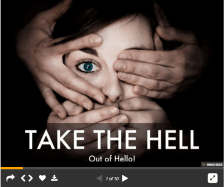The Importance of Visual Communication
Have you noticed the trend toward more and more visual communication? Lisa B. Marshall, aka The Public Speaker, will tell you about an informal year-long experiment where she pitted words against pictures.
Visual communication is becoming more and more important everyday. As you may know, for some time now, the trend for presentation slides has been to eliminate most, if not all, of the words and simply focus on bold, imaginative, engaging images. In the past couple years, I also noticed social media sites like Twitter and LinkedIn are adding more and more visual elements. (Both added the possibility of a large header profile photo and both enhanced the ability to add video, images, and presentations directly into the profile or stream.)
There’s also been a significant increase in subscribers to photo and video-dedicated social media like YouTube, SlideShare, Instagram, Pinterest, Tumblr, Vine, and Snapchat. I have been experimenting with new visual communication software that has hit the marketplace, and I wanted to share with you a little informal experiment that I ran.
New Products Bring Results

I wanted to see if it was a one-off, so I created another one, again based on a popular episode—this time about storytelling. I titled this one, “Are You Another Boring Storyteller?” Again, I picked a quirky image for the slide title page. And once again, the same thing happened: the slide deck got featured and quickly gained traction. So, I decided to post these on my website—I put them in the sidebar on a few popular pages. I wanted to see what would happen over the course of a year. Recently, I received an email from SlideShare telling me that these two slide decks are in the top 10% 
So, then I wondered, “Hmmm…really? How popular are they? Are these slides decks more popular than the original podcasts on which they were based?” So, I asked our talented QDT intern Rebecca to investigate for me. The results? For the self-introductions content, the SlideShare version has earned more than 600,000 views, which is more than four times the number of podcast downloads. The second, newer podcast on storytelling, posted a year or so after the other one, also earned more than 600,000 views in its slideshow format, which is more than twelve times the number of downloads. That’s a BIG difference!
Why Does It Work?
What does this tell us about communication? First, people really like visual presentations! Second, people really like short presentations! Although QDT episodes are already short (about 6-9 minutes), the slides decks can be consumed in one-two minutes. Undoubtedly, a short visual presentation will encourage some people to go on to read or research more, but many people will not. That’s OK. You’ve still communicated key ideas with those people. You’ve planted a seed. And it may grow, and they may come back for more.
A recent study by Microsoft found that, between 2000 and 2013, attention span dropped from 12 seconds to 8 seconds. The researchers speculate that this is due primarily to the heavy use of social media. Now, I’m not saying that’s a good thing, but it’s our job as communicators to reach people where they are. And most people have short attention spans and need visual stimulation to help them focus. This is actually consistent with how we’re wired. According to Dr. Lynell Burmark, associate at the Thornburg Center for Professional Development, “…unless our words, concepts, ideas are hooked onto an image, they will go in one ear, sail through the brain, and go out the other ear. Words are processed by our short-term memory where we can only retain about 7 bits of information… Images, on the other hand, go directly into long-term memory where they are indelibly etched.”
What You Should Do
In other words, visual communication is immediately recognized by the brain, as opposed to words, which have to be processed and take more time. That makes visual communication extremely powerful, and should be a part of any presentation, whether formal or informal. Body language, gestures, and facial expression are as crucial as bold, imaginative, quirky images on a slide presentation.
One thing to remember with short visual presentations: it’s important to connect your pictures to additional information that the interested listener can follow up on. If you look at my example slide decks, you’ll see that I didn’t do a good job of linking my slideshow back to my brand. I should have included a final slide with a clickable link. I hope I can be forgiven for that—again, I was initially just playing around with the software. I am truly surprised by the amazing response I got to these slide decks (and just never went back to update the slides).
So, by example, now I know (and you know) just how important visual communication is. Clearly, this is why we are seeing so much a shift toward the visuals.
Add more visual information, keep the presentations short, and provide information for deeper research. This is how you’ll improve your communication for the audience of today.
So will I give up on podcasting? Absolutely not. I view visual communication as just another channel to deliver my messages—a way to reach more people with shorter, simpler messages. My thought is that the visual communication will lead to even higher podcast downloads and that both channels together fuel the overall growth of my brand.
This is Lisa B. Marshall helping you to lead and influence. If you’d like to learn more about compelling communication, I invite you to read my bestselling books, Smart Talk and Ace Your Interview and listen to my other podcast, Smart Talk. As always, your success is my business.







